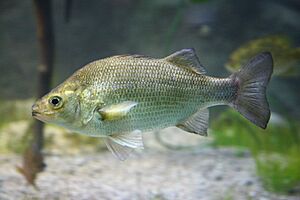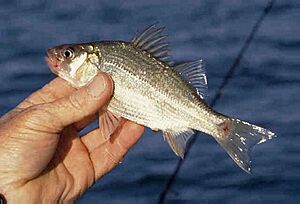White perch facts for kids
Quick facts for kids White perch |
|
|---|---|
 |
|
| Conservation status | |
| Scientific classification | |
| Synonyms | |
|
The white perch (Morone americana) is a type of fish found in eastern North America. Even though it's called a "perch," it's actually part of the temperate bass family, called Moronidae. People often catch white perch for food or for fun. Sometimes, it's also known as "Silver Bass." It's important not to confuse it with the white crappie, which is a different fish sometimes also called "white perch."
Contents
What Does a White Perch Look Like?
White perch are usually silvery-white, which is how they got their name. Depending on where they live and how big they are, some fish might have a darker color near their top fin. This darker color can make them look like they have a "black-back." White perch can grow to be about 49.5 centimeters (19.5 inches) long. They can also weigh up to 2.2 kilograms (4.9 pounds).
Where Do White Perch Live?
White perch like to live in brackish waters, which is a mix of fresh and salt water. But you can also find them in fresh water lakes and rivers. They live along the coastal areas from the St. Lawrence River and Lake Ontario in the north. Their range goes south to the Pee Dee River in South Carolina. You can also find them as far east as Nova Scotia.
They are common in the lower Great Lakes and the Finger Lakes. They also live in Long Island Sound and nearby coastal areas. Other places they call home include the Hudson River and Mohawk River system. They are also found in Delaware Bay and Chesapeake Bay. Sometimes, they even live in small lakes and ponds that are not connected to larger bodies of water.
What Do White Perch Eat?
White perch are known to eat the eggs of many other fish species. This includes the eggs of fish like walleye and other true perches. Sometimes, fish eggs can make up all of their diet. They also like to eat small minnows. These small fish include mudminnows and fathead minnows.
In the Chesapeake Bay, white perch often eat grass shrimp. They also prey on razor clams and bloodworms. These are all common foods found in that region.
White Perch Reproduction
White perch are a species that reproduce very well. A female white perch can lay over 150,000 eggs during one spawning session. This session usually lasts for just over a week. Often, several male fish will be with a female during spawning. Each male might fertilize some of her eggs. The baby fish hatch from the eggs within one to six days after they are fertilized.
Sometimes, a small creature called Lironeca ovalis can be found living in the gills of white perch. This creature is a parasite. Scientists believe that its presence can slow down how much the white perch grows. The population of white perch in the Hudson River is currently growing again after a period of decline.
White Perch as a Nuisance Species
Some states consider the white perch to be a nuisance species. This is because they can cause problems for other fish populations. They have been linked to declines in both walleye and white bass populations. White perch eat a lot of the baitfish that these other species also rely on. They also compete with other fish for food and living space.
Because of these issues, many states have made laws against having live white perch. These states also suggest that if you catch a white perch, you should not put it back into the water. This helps to control their spread and protect other fish.
See also
 In Spanish: Perca para niños
In Spanish: Perca para niños



